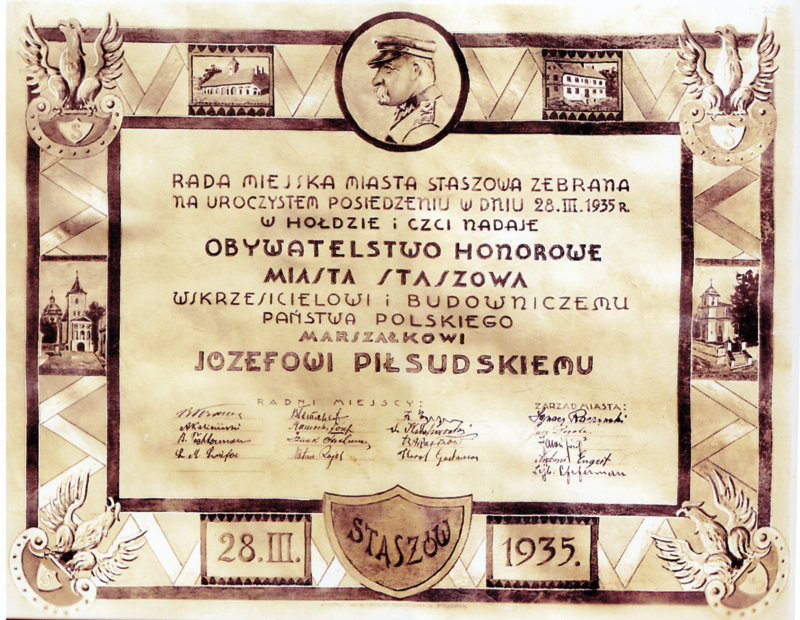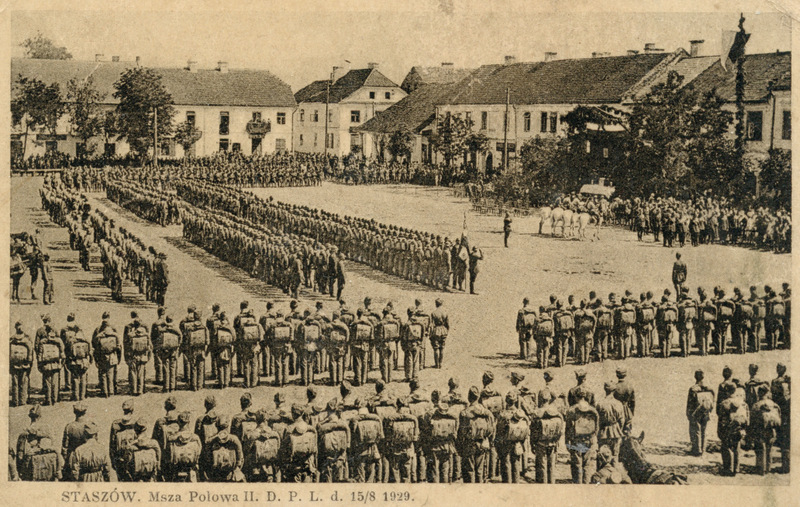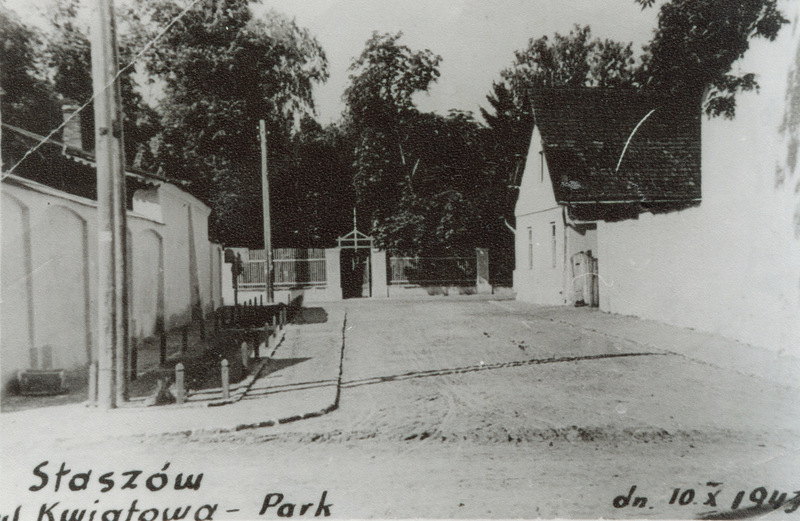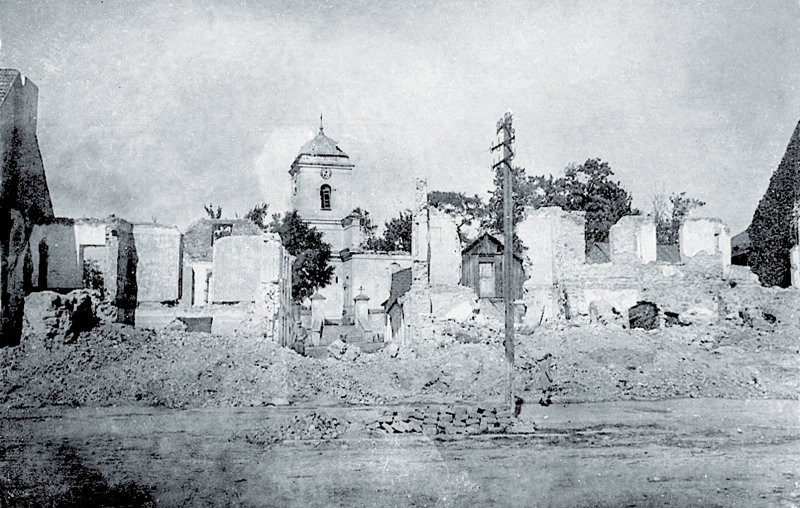
1919 - 1945
 The 1935 Town Council act granting Józef Piłsudski honorary citizenship of Staszów |
Thanks to the Polish Motherland School Foundation's efforts, a Private Coeducational Humanistic Middle School was founded in 1918. Eugeniusz Przybyszewski was its first principal. At the beginning of 1919 Poland's first post-war town council was elected in Staszów. Bolesław Krauze, local apothecary, became the mayor. Wolf Tuchman, a representative of Staszów's Jewish community, was also in the council. Two folk's schools for boys and girls were founded that year. There was also an elementary school in the Jewish community[35].
Another election was held in February, 1920. Bolesław Krauze was re-elected and maintained his office.
In 1921 Staszów had 8357 residents, 56% of them were Jewish.
 A field mass for the Second Legions Infantry Division, Staszów, 1929 |
During the summer of 1923, soldiers of the Second Regiment of Infantry Legions were relocated to Staszów from Pińczów. They stayed at the barracks on Krakowska street.
Small crafts were the main developing branch of Staszów's economy. Furthermore, several tanneries were processing the raw material brought in from surrounding towns. Shoemakers were also developing their businesses at the time, alongside workshops manufacturing whips, harnesses and walking canes.
The interwar period was a golden age of Staszów's cultural life and sports. Various sports clubs were active at the time, including the Jewish "Błyskawica" and "Hakoah".
In December of 1924, Ministry of Internal Affairs annexed Staszówek to the town of Staszów[37].
 Staszów, Krakowska Street, late 1920s |
In 1927, a luxury residential pavilion was given to Staszów's officers. In July of that year another Town Council election was held. Bolesław Krauze was once again re-elected[38], however in June of 1928 he stepped down and was succeeded by Ludwik Górski, a middle school teacher. Efraim Zinger was elected leader of the Jewish commune in 1928.
However, their rule did not last long. In 1929, following a crisis in Staszów magistrate, the Town Council was disbanded. In July a new council was elected. Ignacy Raczyński became the new mayor with Jan Rogala becoming deputy mayor[39]. This new Town Council's headquarters was the magistrate building located at the upper part of Krakowska street.
In June of 1930 the local seven-grade public school's flag was baptized at the Holy Spirit church[40].
In 1930, the "Fredreum" Thespian Society was founded by lieutenant colonel Jan Raźny, who was also a veterinary surgeon[41]. During its almost 10-year long activity, "Fredreum" society staged nearly 30 theatre plays in their main office, which was located in the former Eastern Orthodox Church building[42].
Numerous Jewish societies and associations were active in Staszów at the time, including the Dr. Zamenhoff Esperanto Society, the Talmudic and Religious Sciences Society, and the Jewish Scout Organization – Hashomer Hacair[43].
In 1934 parish priest Wawrzyniec Siek left Staszów, after 30 years of ministry service. He was remembered as a kind rector, who not only cared deeply for his parish but also worked hard to preserve Staszów's history. In 1918, Siek published a book "A historical description of the town and parish of Staszów till 1918". Priest Wacław Wodecki became Staszów's next rector.
In September of 1934 Poland underwent a coeducational education reform. As a result, Staszów's boys' school became Public School no. 1 while the girls' school became Public School no. 2. Not only the education but also healthcare was functioning properly. St. Adam Hospital – supervised by Stefan Niewirowicz since 1929 – was one of the best hospitals in the Kielce region, while Staszów Middle School was the top school in the province.
The officers of Staszów battalion played an important role in the town's cultural and social activity. Staszów remained primarily a town of merchants and artisans, and the local center of trade. Commerce played the dominant role in town's life. The budget was mostly held by Jewish owners, who made up nearly 60% of Staszów's populace.
In 1934 Another election for the Town Council was held. Ignacy Raczyński and Jan Rogala retained their offices, as mayor and deputy mayor, respectively. On March 28, 1935 the Town Council bestowed honorary Staszów citizenship on Józef Piłsudski, First Marshal of Poland. Also that year, Alter Horowitz became the rabbi of Staszów. In 1936 a new parish house was erected, and the Tęczyński Chapel was renovated.
In 1937 middle school students of Staszów published the first issue of "Młode Pióra" news-sheet. Later that year, "Lech" Shoemaker Cooperative was established. Ignacy Kwaśniak became the new parson of Staszów parish.
In April of 1939 the final Town Council election before World War II was held. Ignacy Raczyński was once again re-elected as the mayor, with Jan Rogala also retaining his seat as deputy mayor. At the dawn of war, Staszów had 9706 residents.
On August 28th of 1939 the Second Regiment of Infantry Legions, led by major Józef Kopecki, departed Staszów, seen off by a large gathering of townspeople. Those soldiers journeyed to Sandomierz and were sent to Zelów near Bełchatów in the wake of increasing tensions at the Polish-German border.
World War II broke out on September 1st, 1939 when Germany attacked Poland. As soon as September 4th, refugees from the western parts of Poland arrived in partially abandoned Staszów, trying to escape the warzone. Sadly, their attempts were in vain. Staszów was bombed by German air force the following day, on 5th of September. Fearing further air raids, many of Staszów's residents decided to escape to the East, beyond Wisła river.
On September 7, 1939, the Nazi 29th motorized division rolled through Staszów. The following day Staszów was occupied by German soldiers from the 5th Panzer division[44].
After September Campaign's failure, Poland became occupied by Nazi Germany. This also marked the beginning of Germans carrying out their planned complete destruction of all Poles, through massacres and executions of Polish civilians.
First arrests in Staszów took place on Boxing Day of Christmas, 1939. Among those arrested by Nazis were: Stanisław Łukasik, Stanisław Warchałowski, Zbigniew Chmielewski, Jan Staszewski, Mojżesz Segal. Initially they were held in the Staszów magistrate, but on April 1940 they were sent to the death camp in Oświęcim. In October, Nazis established a military police station and reinstated the mayor's office. Ignacy Raczyński remained Staszów's mayor even during that time, however his time at the office was very brief; he was arrested on August 1940, and then sent to the Buchenwald concentration camp, where he was killed in 1941.
Józef Suchan, a pro-German lawyer, was chosen by Nazis as the next mayor of Staszów[45].
At the end of January of 1940 a Schutzstaffel (SS) battalion arrived in Staszów. Town's residents, much like other Poles, did not succumb to their oppressors and did not accept loss of their independence. An outpost of Union of Armed Struggle – Home Army was secretly established. "Jędrusie", Peasants' Battalions, National Military Organization – these resistance groups were all actively fighting back against Nazi invaders.
In June of 1941, a Jewish police force – so-called "security service" – was established by the Germans. During autumn of that year Stefan Kopczyński started giving secret classes at dr. Karbownicki's house. Towards the end of 1941 Nazis had intensified their arrests of Poles and Jews. Those "arrests" invariably ended up with executions or being sent to a death camp.
On June 15, 1942, Germans created a Jewish ghetto spanning across Złota St., Bóźnicza St., Gęsia St., Stodolna St. and Krakowska St. In August of that year, forced-labour tailoring workshops – which served the Germans – were opened in the synagogue and at the middle school in the ghetto. November of 1942 was a tragic month for Jews of Staszów. On November 8th, during what is now called a "black Sunday", Staszów's Jewish community was exterminated. That day Nazis took away nearly 6000 Jews. Some of them were shot dead still in Staszów, others were murdered en route to Szczucin, and the rest of them were tormented and killed at the Bełżec extermination camp[46]. Only a few of Staszów's Jews managed to escape or hide away, and somehow survived that horrible atrocity[47].
 Staszów, Park at Kwiatowa Street, 9.10.1943 |
Polish guerrillas intensified their retaliatory operations in Staszów. On November 3, 1943, a Home Army squad – led by lieutenant Kabata – assassinated the pro-German mayor, Józef Suchan. However it was only a temporary blow to the German authorities; as soon as next month they had replaced Suchan with Stanisław Wojciechowski.
On July of 1944 regiments of Peasants' Battalions destroyed the grenadier police station in Staszów and seized munitions from German storehouses.
On July 31, 1944, Polish guerrillas cooperating with the Red Army temporarily liberated Staszów. However they were forced out by German armies on the following day.
Staszów was once again liberated, this time permanently, on August 3rd of 1944[48]. In a cruel act of desperate retaliation, Germans conducted a large-scale air raid during the night of 8th and 9th of August. The bombing dealt a heavy blow to the town. About 80% of Staszów's buildings were destroyed that night, including the historic Holy Spirit church.
In the middle of August 1944 the front line had settled. Russian army managed to establish a bridgehead in vicinity of Staszów. Russians concentrated the 1st Ukrainian Front near Rytwiany, Połaniec and Mokre. That regiment was being led by marshal Ivan Konev. Major Semonov became war commander of Staszów, and gave mayoral duties to Jan Rogala, former deputy mayor. Most of Staszów region's citizens were evicted in 1944. I n November, St. Adam Hospital's crew and patients were evacuated to the Moszyński palace in Łoniów; Staszów's middle school was reinstated in Połaniec.
On January 12, 1945, a great offensive of the Ukrainian Front began. Many Polish regiments were part of the Front. The offensive took off from a small village Mokre – located to the north-west of Staszów – and kept moving to the west until it reached and helped conquer Berlin.

The Holy Spirit Church lying in ruins after the war
Dariusz Kubalski Ph.D.
English translation by Michał Mróz
Archival pictures from the personal collection of W. Migoń
Footnotes:
[35] M. Zarębski, Staszów wczoraj i dziś, Staszów 1999, p. 46-47; D. Kubalski, Życie społeczno-kulturalne w Staszowie w latach 1918-1939, Staszów 1996, p. 20
[36] AP Kielce, UWK/I sign. 3193
[37] AP Kielce, UWK/I sign. 4492
[38] AP Kielce, UWK/I sign. 4119
[39] ibidem
[40] D.Kubalski, Życie społeczno-kulturalne w Staszowie w latach 1918-1939, Staszów 1996, p. 17-18
[41] AP Kielce, UWK/I sign. 3088
[42] M. Zarębski, Staszowski teatr Fredreum i jego twórca,/in:/Almanach staszowski 2002 r., Staszów 2003, p. 46-51
[43] AP Kielce, UWK/I sign. 3212, 3911, 3258
[44] J. Więckowski, Wrzesień 1939 roku na Ziemi Staszowskiej,/in:/ Almanach Staszowski 2002 r., Staszów 2003, p. 59
[45] M. Zarębski, Staszów wczoraj i dziś, Staszów 1999, p. 73-74
[46] M. Zarębski, Życie i zagłada Żydów staszowskich, Staszów 1992, p. 31-33
[47] E. Fąfara, Gehenna ludności żydowskiej, Warszawa 1983, p. 362-363
[48] J. Stawiński, Wyzwolenie miasta,/in:/Almanach Staszowski 1994, Staszów 1994, p. 174-175


